
Don Quixote is a Spanish epic novel by Miguel de Cervantes. It was originally published in two parts, in 1605 and 1615. Considered a founding work of Western literature, it is often labelled as the first modern novel and the greatest work ever written. Don Quixote is also one of the most-translated books in the world and one of the best-selling novels of all time.

Miguel de Cervantes Saavedra was an Early Modern Spanish writer widely regarded as the greatest writer in the Spanish language and one of the world's pre-eminent novelists. He is best known for his novel Don Quixote, a work often cited as both the first modern novel and "the first great novel of world literature". A 2002 poll of 100 well-known authors voted it the "best book of all time", as voted by the judges from among the "best and most central works in world literature".

Joanot Martorell was a Valencian knight and writer, best known for authoring the novel Tirant lo Blanch, written in Catalan/Valencian and published at Valencia in 1490. This novel is often regarded as one of the peaks of the literature in Catalan language and it played a major role in influencing later writers such as Miguel de Cervantes, who, in the book burning scene of Don Quixote, says "I swear to you, my friend, this is the best book of its kind in the world". The novel deals with the adventures of a knight in the Byzantine Empire; it is considered one of the first works of alternate history.
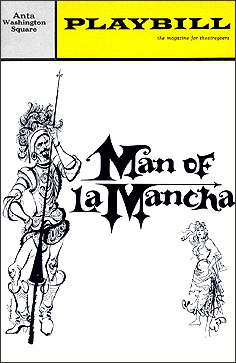
Man of La Mancha is a 1965 musical with a book by Dale Wasserman, music by Mitch Leigh, and lyrics by Joe Darion. It is adapted from Wasserman's non-musical 1959 teleplay I, Don Quixote, which was in turn inspired by Miguel de Cervantes and his 17th-century novel Don Quixote. It tells the story of the "mad" knight Don Quixote as a play within a play, performed by Cervantes and his fellow prisoners as he awaits a hearing with the Spanish Inquisition. The work is not and does not pretend to be a faithful rendition of either Cervantes' life or Don Quixote. Wasserman complained repeatedly about people taking the work as a musical version of Don Quixote.
This article contains information about the literary events and publications of 1605.

Tirant lo Blanch, in English Tirant the White, is a chivalric romance written by the Valencian knight Joanot Martorell, finished posthumously by his friend Martí Joan de Galba and published in the city of Valencia in 1490 as an incunabulum edition. The title means "Tirant the White" and is the name of the romance's main character who saves the Byzantine Empire.
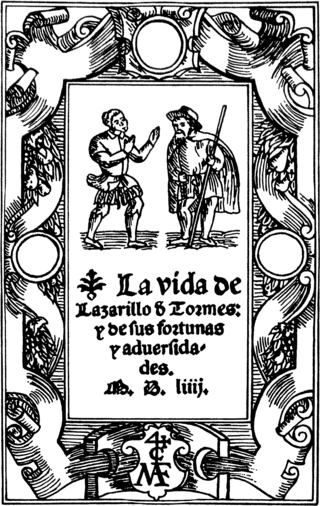
The Life of Lazarillo de Tormes and of His Fortunes and Adversities is a Spanish novella, published anonymously because of its anticlerical content. It was published simultaneously in three cities in 1554: Alcalá de Henares, Burgos and Antwerp. The Alcalá de Henares edition adds some episodes which were most likely written by a second author. It is most famous as the book establishing the style of the picaresque satirical novel.
"Pierre Menard, Author of the Quixote" is a short story by Argentine writer Jorge Luis Borges.

As a literary genre, the chivalric romance is a type of prose and verse narrative that was popular in the noble courts of high medieval and early modern Europe. They were fantastic stories about marvel-filled adventures, often of a chivalric knight-errant portrayed as having heroic qualities, who goes on a quest. It developed further from the epics as time went on; in particular, "the emphasis on love and courtly manners distinguishes it from the chanson de geste and other kinds of epic, in which masculine military heroism predominates."

Andreï Sergueïevitch Makine is a French novelist. He also publishes under the pseudonym Gabriel Osmonde. Makine's novels include Dreams of My Russian Summers (1995) which won two top French awards, the Prix Goncourt and the Prix Médicis. He was elected to seat 5 of the Académie Française on 3 March 2016, succeeding Assia Djebar.
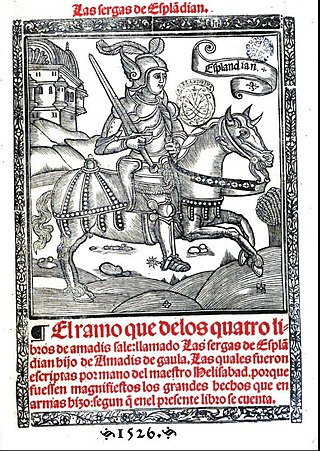
Las Sergas de Esplandián is a novel written by Garci Rodríguez de Montalvo in the late fifteenth or early sixteenth century. The novel is a sequel to a popular fifteenth century set of chivalric romance novels, Amadís de Gaula. The novel achieved particular notability in 1862, when Edward Everett Hale concluded that the novel was the origin of the name California.

Cide Hamete Benengeli is a fictional Arab Muslim historian created by Miguel de Cervantes in his novel Don Quixote, who Cervantes says is the true author of most of the work. This is a skilful metafictional literary pirouette that seems to give more credibility to the text, making the reader believe that Don Quixote was a real person and the story is decades old. However, it is obvious to the reader that such a thing is impossible, and that the pretense of Cide Hamete's work is meant as a joke.

Hispanism is the study of the literature and culture of the Spanish-speaking world, principally that of Spain and Hispanic America. It may also entail studying Spanish language and cultural history in the United States and in other presently or formerly Spanish-speaking countries in Africa, Asia, and the Pacific, such as Equatorial Guinea and the former Spanish East Indies.

Alonso Quijano is the personal name of the famous fictional hidalgo who is better known as Don Quixote, a name he invents after falling into insanity. Alonso Quijano/Don Quixote is the leading character of the 1605/1615 novel Don Quixote de la Mancha, written by Miguel de Cervantes.
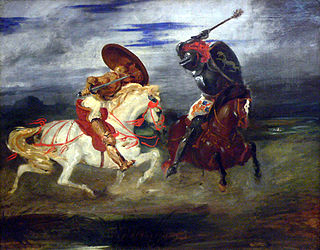
During the Middle Ages, Medieval Europe was engaged in constant warfare. European warfare during the Middle Ages was marked by a transformation in the character of warfare from antiquity, changing military tactics, and the role of cavalry and artillery. In addition to military, tactical and technological innovations during this period, chivalric military and religious ideals arose, giving motivation for engagement in the ceaseless warfare. In the Iberian Peninsula, chivalric ideals and institutions would be adopted and exercised with more fervour than anywhere else.

"Rinconete y Cortadillo" is one of the twelve short stories included in Novelas Ejemplares, by Spanish writer Miguel de Cervantes. It describes the comical adventures of two petty criminals as they travel to Seville and are then taken in by the city's thieves' guild. Seville at the time was a rich city with marked social contrasts, being the entrepôt of Spain and the new world of the Americas.
Translation criticism is the systematic study, evaluation, and interpretation of different aspects of translated works. It is an interdisciplinary academic field closely related to literary criticism and translation theory. It includes marking of student translations, and reviews of published translations.
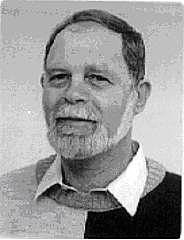
Gideon Toury was an Israeli translation scholar and professor of Poetics, Comparative Literature and Translation Studies at Tel Aviv University, where he held the M. Bernstein Chair of Translation Theory. Gideon Toury was a pioneer of Descriptive Translation Studies.
J. R. R. Tolkien made use of pseudotranslation in The Lord of the Rings for two reasons: to help resolve the linguistic puzzle he had accidentally created by using real-world languages within his legendarium, and to lend realism by supporting a found manuscript conceit to frame his story.













